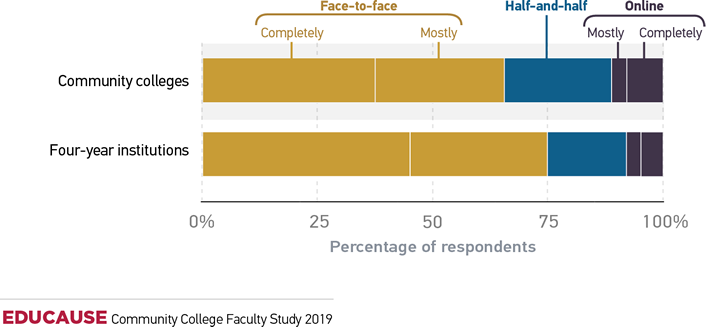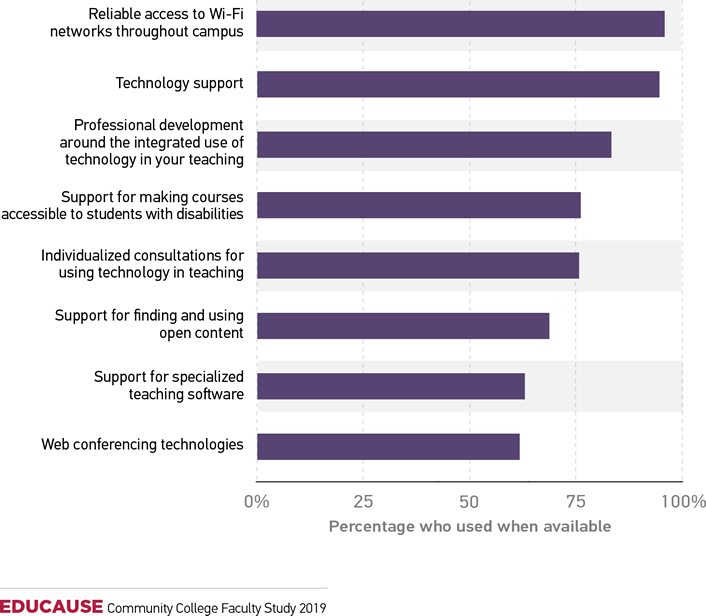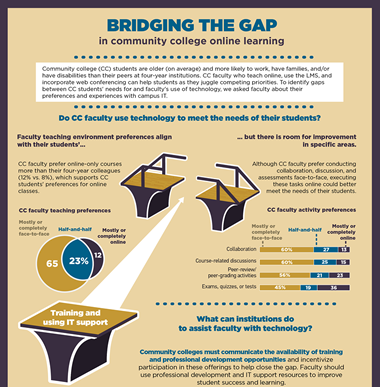Community colleges have historically positioned themselves as institutions that respond to local and regional educational needs. Understanding community college faculty technology preferences and experiences can aid institutional efforts to increase student success.

ECAR Study of Community College Faculty and Information Technology, 2020 provides community college technology and higher education leaders with recommendations for addressing the most pressing technology support and solution needs for faculty, with the goal of enriching faculty teaching experiences on campus and helping advance student success.
Community college faculty teach approximately five million undergraduate students, and these students are more likely than those at four-year institutions to come from underrepresented groups, have families, work, and be underprepared for college. Community colleges have historically positioned themselves as institutions that respond to local and regional educational needs. Many two-year and AA faculty spend more time teaching and less time conducting research than do their counterparts at four-year institutions. Because most institutions have been forced to migrate their face-to-face courses to remote learning environments in response to the COVID-19 pandemic, it is more important now than ever that community college leaders understand their faculty's experiences with campus technology.
In this study we present:
- Faculty demographics
- Campus technology use and support
- Learning environment preferences
- Faculty preferences for in-class device use
- Student success tools
Access other materials: Executive Summary | Infographic
Key Findings
Drawing on survey data from more than 1,900 faculty across 44 US institutions, the report highlights a number of important findings related to community college faculty technology preferences, supports, and experiences, with the goal of aiding community college technology and higher education professionals in improving faculty teaching experiences and success. Among the most important findings for campus leaders and community college faculty to consider are in the areas of learning environments, technologies, and support.
Learning Environment Preferences
Although they prefer online or mostly online courses more than their four-year colleagues, community college faculty primarily prefer face-to-face or mostly face-to-face learning environments.
To address the needs of their communities and an expanding population of nontraditional students, two-year institutions will need to increase faculty skills and interest in online instruction, particularly in light of the migration to online or some form of blended learning this year. Read more about learning environment preferences >

Campus Technology Use and Support
Community college faculty aren't using technologies that support student success, such as web conferencing or open educational resources (OER), as much as they could.
Web conferencing can increase student engagement in online learning, and the use of OER can decrease costs for course materials. When they get support for these technologies that can assist with remote learning, faculty rate that IT support highly. Read more about campus technology use and support >

Support for Learning Technologies
IT support has a positive impact on faculty attitudes and use of technology in teaching.
Overall, faculty who take advantage of IT support find value in it. For example, 60% of faculty who had used support for web conferencing rated that support as good or excellent. Faculty need to tap into the IT support that is provided by their institution. IT support might make a difference in engaging students and ensuring that online classes support student success. Read more about support for learning technologies >
How Can My Institution Use This Information?
If we can understand the factors that facilitate or inhibit faculty's use of technology, institutions can help them use technology to support student success. Since community colleges continue to put emphasis on online course offerings, these findings can also be used to improve online learning for students and inform the approaches community college campuses will take in fall of 2020 should the pandemic persist.

Infographic
Download the ECAR Study of Community College Faculty and Information Technology, 2020 infographic now.
Related Resources
For more on student and faculty technology experiences, see these EDUCAUSE research hubs:
Joseph D. Galanek is Senior Researcher at EDUCAUSE.
Dana C. Gierdowski is Researcher at EDUCAUSE.
© 2020 Joseph D. Galanek and Dana C. Gierdowski. The text of this work is licensed under a Creative Commons BY-NC-ND 4.0 International License.
